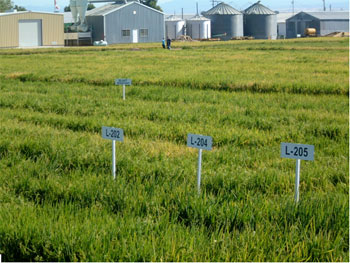Author:
Allen Van Deynze, University of California, Davis

Image Credit: The Seed Biotechnology Center at UC Davis.
This page summarizes variety development information that was developed by the Seed Biotechnology Center at UC Davis for SeedQuest and aggregated for eXtension.
Introduction
Variety development in it simplest form began centuries ago, with the first selections and propagation of desirable plants from a pool of segregating germplasm. Today it involves a team of trained individuals and sophisticated management of genetic resources and selection technologies, including marker-assisted breeding. It is combined with seed production, seed quality, and distribution systems to deliver high-quality products to growers. To learn more, see variety development.
Plant Breeding
Plant breeding is the science of accessing or generating genetic variation, selection of desirable plants, fixing of traits, and reproduction of plant varieties. The bases of plant breeding are the genetic principles of inheritance defined by Gregor Mendel in the late 19th century and their application for variety development. This has been further improved by implementing experimental designs that allow selection of desirable phenotypes and application of marker-assisted breeding to define genotypes. To learn more, see plant breeding.
Genetic Engineering
Genetic engineering is the direct manipulation of a plant’s DNA using the techniques of molecular cloning and plant transformation. Specific portions of DNA, usually genes that code for proteins, can be isolated and amplified from one organism, and inserted into the genome of another organism. Genetic engineering allows for specific genetic information to be exchanged between organisms without breeding. For more information, see genetic engineering.
Genotyping
Genotyping is the process of determining the genetic makeup of individuals. Genotype can refer to the genetic makeup of a single location in the genome, multiple locations in the genome, or the sequence of the entire genome. Genotyping has many uses in plant breeding, such as the ability to test seedlings for the presence of genes involved in disease resistance. Genotyping also allows breeders to quickly determine if a plant is true-breeding, or homozygous, for important genes. For more information, see genotyping.
Induced Mutations
Induced mutations are created when plant DNA is exposed to mutagenizing agents that alter the DNA sequence. Naturally occurring DNA mutations are the source of all variation between organisms. Plant breeders looking for new sources of genetic variation in crop plants can induce mutations to generate artificial variation. For more information, see induced mutation.
Marker-Assisted Breeding
Marker-assisted breeding uses molecular markers, usually DNA or proteins, to select plants for breeding or cultivation. Heritable traits are coded within the genome and expressed as proteins. Most agronomically important traits, or phenotypes, result from the combined effect of numerous portions of the genome and the expressed proteins. Marker-assisted breeding allows breeders to identify individuals based on their genotype and more rapidly incorporate desired phenotypes into new varieties. For more information, see marker-assisted breeding.
Phenomics
Phenomics is the study of a plant’s phenome, the collection of all its traits, or phenotypes. Phenotypes are influenced by genetics (genotypes) and environmental conditions. As the process of genotyping plants has become simplified, there is much interest in developing methods to measure diverse plant phenotypes. For more information, see phenomics.
Proteomics
Proteomics is the study of a plant’s proteome, the collection of all its proteins. The structure of protein molecules is determined by an individual’s genotype and represents the heritable portion of a plant’s phenotype. However, unlike the plant’s genome, proteins interact directly with the environment. The composition and activity of the proteome changes in response to environmental cues. For more information, see proteomics.
External Links
- Seed Biotechnology Center [Online]. UC Davis Department of Plant Sciences. Available at: http://sbc.ucdavis.edu/index.htm (verified 24 Mar 2012).
- SeedQuest [Online]. SeedQuest. Available at: http://www.seedquest.com/ (verified 24 Mar 2012).
Funding Statement
Development of this page was supported in part by the National Institute of Food and Agriculture (NIFA) Solanaceae Coordinated Agricultural Project, agreement 2009-85606-05673, administered by Michigan State University. Any opinions, findings, conclusions, or recommendations expressed in this publication are those of the author(s) and do not necessarily reflect the view of the United States Department of Agriculture.
PBGworks 725
